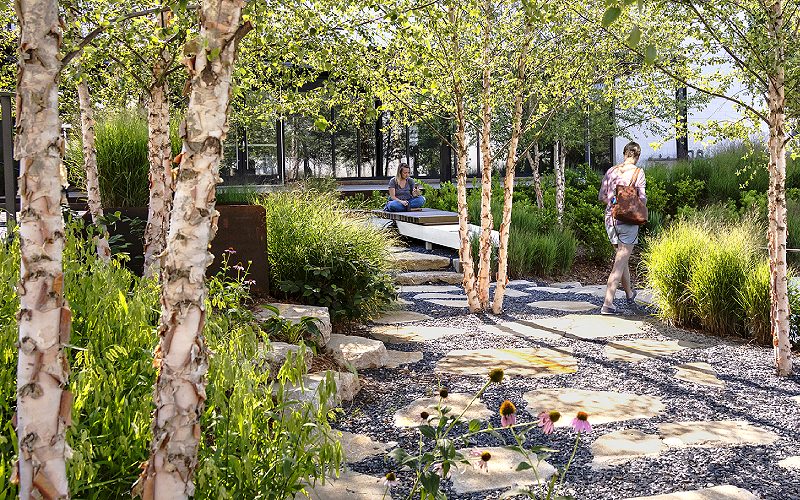 “Large pieces of concrete were carefully tagged and salvaged from the loading dock for repurposing within the Birch Grove and gabion walls. A 100 percent native Piedmont Region planting palette was used.” ASLA 2021 Professional General Design Honor Award. Atlanta Diaries, Atlanta, Georgia. Perkins&Will / Sahar Coston-Hardy
“Large pieces of concrete were carefully tagged and salvaged from the loading dock for repurposing within the Birch Grove and gabion walls. A 100 percent native Piedmont Region planting palette was used.” ASLA 2021 Professional General Design Honor Award. Atlanta Diaries, Atlanta, Georgia. Perkins&Will / Sahar Coston-HardyASLA has released a set of freely-available guides designed to help landscape architects, specifiers, and industry partners achieve the goals of the ASLA Climate Action Plan, which includes making the profession zero-emission by 2040.
The resources were developed by the ASLA Biodiversity and Climate Action Committee, a group of landscape architects charged with implementing key aspects of the plan, including how to decarbonize projects while increasing biodiversity. Landscape architects play an important role in designing nature-based solutions to climate change that also help communities become more resilient.
“These guides are the practical tools landscape architects have been asking for. They help turn every project into an opportunity to get on a path to zero emissions,” said ASLA CEO Torey Carter-Conneen. “They take our high-level goals and break it down for everyone – showing landscape architects and industry partners how to get there, step by step.”
“With climate impacts only worsening, we know we need to change how we design – and make that shift faster,” said April Phillips, FASLA, Chair of the ASLA Biodiversity and Climate Action Committee. “So we got to work, creating substantive how-to’s any landscape architect, specifier, or industry partner can pick up and start using today.”
New resources include:
Decarbonizing Specifications
Guidelines for Landscape Architects, Specifiers, and Contractors
Developed by:
Chris Hardy, ASLA, PLA, Sasaki
Alejandra Hinojosa, Affil. ASLA, LPA Design Studios
Elizabeth Moskalenko, ASLA, PLA, ASLA NY Chapter
Bryce Carnehl, Corporate ASLA, Hunter Industries
These guidelines make it easier for landscape architects to more effectively reduce greenhouse gas emissions from project design and construction. Sections cover seven key design principles and 18 areas of specification.
They are for landscape architects and designers, specifiers, contractors, and manufacturers who want to cut emissions and increase carbon storage and sequestration faster.
Decarbonizing the Design Process
A Phase by Phase Approach for Landscape Architects
Developed by:
Alejandra Hinojosa, Affil. ASLA, LPA Design Studios
Mariana Ricker, ASLA, SWA
This guide offers a phase-by-phase structure to decarbonize design through big ideas, strategies, and best practices. It is high-level, offering approaches that can be implemented regardless of project type, scope, and scale.
The guide offers decarbonization opportunities for:
- Project kickoff
- Schematic design
- Design development
- Construction documents
- Construction administration
- Operations and maintenance
Navigating Environmental Product Data
A Guide for Landscape Architects, Specifiers, and Industry Partners
Developed by:
Amy Syverson-Shaffer, ASLA, Landscape Forms
Sasha Anemone, ASLA, Salt Landscape Architects
The products and materials that landscape architects specify for their projects play a significant role in the overall global warming potential (GWP) of a project. They can also impact biodiversity, air and water quality.
The guide outlines how environmental product declarations (EPDs) and other environmental reporting can be used to understand the environmental impacts of landscape materials and products and make decisions to reduce those impacts.
These new resources are what ASLA members and industry partners stated they needed in survey responses gathered over the past two years.
The guides are designed for the broad landscape architecture community, including:
- Landscape architects
- Landscape designers
- Other specifiers
- Industry partners that develop the products and services used in landscape architecture projects
The best practices in the guides can also inform the work of planners, architects, engineers, and urban designers.
The ASLA Climate Action Plan calls for all landscape architecture projects to achieve these goals by 2040:
- Achieve zero embodied and operational emissions and increase carbon sequestration
- Provide significant economic benefits in the form of measurable ecosystem services, health co-benefits, sequestration, and green jobs
- Address climate injustices, empower communities, and increase equitable distribution of climate investments
- Restore ecosystems and increase and protect biodiversity
26 CEOs of landscape architecture firms recently released a letter committing to the goals of the plan.